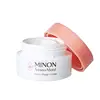What's inside
What's inside
 Key Ingredients
Key Ingredients

 Benefits
Benefits

 Concerns
Concerns

 Ingredients Side-by-side
Ingredients Side-by-side

Water
Skin ConditioningGlycerin
HumectantSqualane
EmollientButylene Glycol
HumectantDipropylene Glycol
HumectantTriisostearin
Skin ConditioningPhytosteryl Macadamiate
Skin ConditioningBehenyl Alcohol
EmollientSorbitol
HumectantPhytosteryl/Octyldodecyl Lauroyl Glutamate
Skin ConditioningSimmondsia Chinensis Seed Oil
EmollientCetyl Palmitate
EmollientBeeswax
Emulsion StabilisingCapric Acid
CleansingPetrolatum
EmollientPhytosteryl/Behenyl/Octyldodecyl Lauroyl Glutamate
Skin ConditioningButyrospermum Parkii Butter
Skin ConditioningPhytosteryl/Isostearyl/Cetyl/Stearyl/Behenyl Dimer Dilinoleate
Skin ConditioningGlyceryl Stearate
EmollientDimethicone
EmollientBeheneth-30
CleansingHydrogenated Lecithin
EmulsifyingPhenoxyethanol
PreservativePEG-40 Hydrogenated Castor Oil
EmulsifyingSerine
MaskingCarbomer
Emulsion StabilisingBatyl Alcohol
EmollientArginine
MaskingEthylhexylglycerin
Skin ConditioningGlyceryl Caprylate
EmollientSodium PCA
HumectantAlanine
MaskingGlycine
BufferingStearyl Glycyrrhetinate
Skin ConditioningPCA Ethyl Cocoyl Arginate
MoisturisingLysine Hcl
Skin ConditioningThreonine
Valine
MaskingHistidine
HumectantProline
Skin ConditioningAmmonium Ferric Pentetate
HumectantLeucine
Skin Conditioning1,2-Hexanediol
Skin ConditioningCarnosine
Skin ConditioningPolyquaternium-61
Skin ConditioningPolyglyceryl-10 Laurate
Skin ConditioningSodium Hyaluronate
HumectantTocopherol
AntioxidantWater, Glycerin, Squalane, Butylene Glycol, Dipropylene Glycol, Triisostearin, Phytosteryl Macadamiate, Behenyl Alcohol, Sorbitol, Phytosteryl/Octyldodecyl Lauroyl Glutamate, Simmondsia Chinensis Seed Oil, Cetyl Palmitate, Beeswax, Capric Acid, Petrolatum, Phytosteryl/Behenyl/Octyldodecyl Lauroyl Glutamate, Butyrospermum Parkii Butter, Phytosteryl/Isostearyl/Cetyl/Stearyl/Behenyl Dimer Dilinoleate, Glyceryl Stearate, Dimethicone, Beheneth-30, Hydrogenated Lecithin, Phenoxyethanol, PEG-40 Hydrogenated Castor Oil, Serine, Carbomer, Batyl Alcohol, Arginine, Ethylhexylglycerin, Glyceryl Caprylate, Sodium PCA, Alanine, Glycine, Stearyl Glycyrrhetinate, PCA Ethyl Cocoyl Arginate, Lysine Hcl, Threonine, Valine, Histidine, Proline, Ammonium Ferric Pentetate, Leucine, 1,2-Hexanediol, Carnosine, Polyquaternium-61, Polyglyceryl-10 Laurate, Sodium Hyaluronate, Tocopherol
Water
Skin ConditioningGlycerin
HumectantCetyl-Pg Hydroxyethyl Palmitamide
Skin ConditioningTrisiloxane
Skin ConditioningDimethicone
EmollientHydrogenated Polydecene
EmollientPEG-3 Dimethicone
Skin ConditioningAllantoin
Skin ConditioningMagnesium Sulfate
Butylene Glycol
HumectantIsostearyl Glyceryl Ether
Skin ConditioningPEG-12 Dimethicone
Skin ConditioningSuccinic Acid
BufferingSodium Hydroxide
BufferingEucalyptus Globulus Leaf Extract
PerfumingTocopherol
AntioxidantMethylparaben
PreservativeWater, Glycerin, Cetyl-Pg Hydroxyethyl Palmitamide, Trisiloxane, Dimethicone, Hydrogenated Polydecene, PEG-3 Dimethicone, Allantoin, Magnesium Sulfate, Butylene Glycol, Isostearyl Glyceryl Ether, PEG-12 Dimethicone, Succinic Acid, Sodium Hydroxide, Eucalyptus Globulus Leaf Extract, Tocopherol, Methylparaben
 Reviews
Reviews

Ingredients Explained
These ingredients are found in both products.
Ingredients higher up in an ingredient list are typically present in a larger amount.
Butylene Glycol (or BG) is used within cosmetic products for a few different reasons:
Overall, Butylene Glycol is a safe and well-rounded ingredient that works well with other ingredients.
Though this ingredient works well with most skin types, some people with sensitive skin may experience a reaction such as allergic rashes, closed comedones, or itchiness.
Learn more about Butylene GlycolDimethicone is a type of synthetic silicone created from natural materials such as quartz.
What it does:
Dimethicone comes in different viscosities:
Depending on the viscosity, dimethicone has different properties.
Ingredients lists don't always show which type is used, so we recommend reaching out to the brand if you have questions about the viscosity.
This ingredient is unlikely to cause irritation because it does not get absorbed into skin. However, people with silicone allergies should be careful about using this ingredient.
Note: Dimethicone may contribute to pilling. This is because it is not oil or water soluble, so pilling may occur when layered with products. When mixed with heavy oils in a formula, the outcome is also quite greasy.
Learn more about DimethiconeGlycerin is already naturally found in your skin. It helps moisturize and protect your skin.
A study from 2016 found glycerin to be more effective as a humectant than AHAs and hyaluronic acid.
As a humectant, it helps the skin stay hydrated by pulling moisture to your skin. The low molecular weight of glycerin allows it to pull moisture into the deeper layers of your skin.
Hydrated skin improves your skin barrier; Your skin barrier helps protect against irritants and bacteria.
Glycerin has also been found to have antimicrobial and antiviral properties. Due to these properties, glycerin is often used in wound and burn treatments.
In cosmetics, glycerin is usually derived from plants such as soybean or palm. However, it can also be sourced from animals, such as tallow or animal fat.
This ingredient is organic, colorless, odorless, and non-toxic.
Glycerin is the name for this ingredient in American English. British English uses Glycerol/Glycerine.
Learn more about GlycerinTocopherol (also known as Vitamin E) is a common antioxidant used to help protect the skin from free-radicals and strengthen the skin barrier. It's also fat soluble - this means our skin is great at absorbing it.
Vitamin E also helps keep your natural skin lipids healthy. Your lipid skin barrier naturally consists of lipids, ceramides, and fatty acids. Vitamin E offers extra protection for your skin’s lipid barrier, keeping your skin healthy and nourished.
Another benefit is a bit of UV protection. Vitamin E helps reduce the damage caused by UVB rays. (It should not replace your sunscreen). Combining it with Vitamin C can decrease sunburned cells and hyperpigmentation after UV exposure.
You might have noticed Vitamin E + C often paired together. This is because it is great at stabilizing Vitamin C. Using the two together helps increase the effectiveness of both ingredients.
There are often claims that Vitamin E can reduce/prevent scarring, but these claims haven't been confirmed by scientific research.
Learn more about TocopherolWater. It's the most common cosmetic ingredient of all. You'll usually see it at the top of ingredient lists, meaning that it makes up the largest part of the product.
So why is it so popular? Water most often acts as a solvent - this means that it helps dissolve other ingredients into the formulation.
You'll also recognize water as that liquid we all need to stay alive. If you see this, drink a glass of water. Stay hydrated!
Learn more about Water